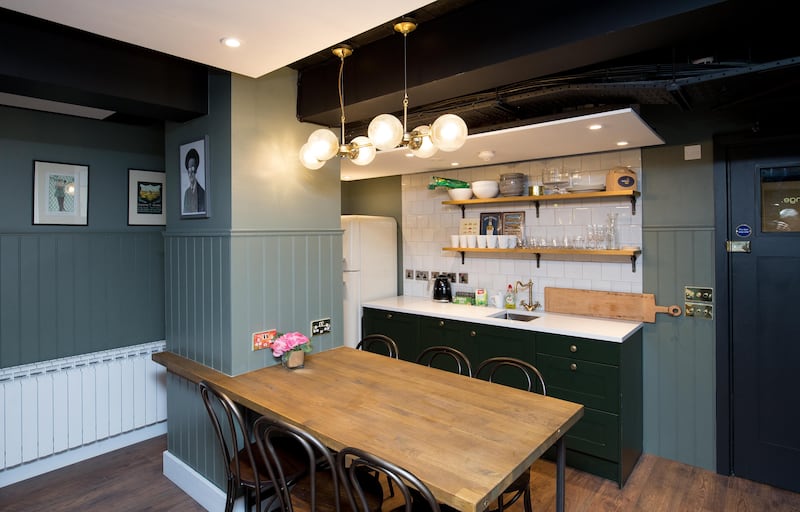Looking for a room to rent in Dublin? Well, if you like the sound of Instagram-ready interiors, curated housemates and a Smeg fridge, co-living might be for you. Just bring your wallet and maybe get rid of some of your stuff.
As a new co-living housing block gets ready to launch in Dún Laoghaire next month, with stays of six to 12 months available, we take a look at what co-living is, who it appeals to – and just how much it costs.
What’s not to like?
A bit like a regular apartment share, co-living is also a bit like a hotel, in that bedrooms can be smaller and all the fiddly utility bills and maintenance drama is taken care of by someone else. You will pay a premium for this of course.
The interiors at the new Niche scheme in Dún Laoghaire tick every box in the millennial style book. Mixing mid-century modern furnishings with industrial chic, occupants will have plenty of Instagramable backdrops. Crittall windows, exposed ducts, Scandi coffee tables – it’s all there.
The development boasts shared MasterChef kitchens, where you can “swap recipes” with your co-living “neighbours”, a private cinema and games room, roof terraces, a 24/7 onsite gym, work desks and private meeting rooms with video conferencing and printing. At Node, in Dublin’s city centre, communal spaces include a rooftop terrace and a “residents lounge”, which can be used as a co-working space. Renters also have private access to Fitzwilliam Square park. What’s not to like?
Banned
Quite a bit, it seems.
Co-living developments have gained a foothold in cities the world over. San Francisco, New York, Miami, Tokyo, London, Manchester, Berlin, Barcelona – anywhere you can find a population of thrusting young professionals challenged by the cost and availability of housing, you’ll find co-living.
Accommodation designed for multiple individuals with shared facilities, such as work and cooking spaces, has been on the increase for the best part of a decade, according to the World Economic Forum.
Those in favour of this type of accommodation say it is part of the solution to the urban housing crisis, providing much-needed housing for young people locked out of the market. It also caters for a growing demographic of single-person households with more mobile living and working patterns.
Ireland was all set to join the trend. In 2018 then minister for housing Eoghan Murphy introduced planning regulations that allowed co-living developments that provide just 12 square metres of personal living space for a single person. Most bed spaces in planning applications lodged were larger, but the regulations were controversial.
With smaller spaces for living in, developers could maximise the number of units built in a development, and the co-living concept soon became very popular.
Then the backlash took hold, and the minister drew criticism for describing co-living as “exciting” and saying young people would “sacrifice less space for less rent”. He also made the comparison between co-living spaces and a “very trendy, kind of boutique hotel-type place”. The comparison “wasn’t a good one”, he later acknowledged.
Just two years later Sinn Féin tabled a Bill to ban co-living. Party housing spokesman Eoin Ó Broin described co-living as a “greed-driven model that seeks to pack as many people as possible into as small a space as possible to maximise profits”. The room size of units “is the size of an average car-parking space”, he said.
Then Taoiseach Micheál Martin acknowledged co-living accommodation had the potential to become “glorified tenement living” based on some of the planning applications he had seen.
In November 2020, after a review of the planning guidelines, Minister for Housing Darragh O’Brien issued a de facto ban on new co-living developments. Expressing concern about the volume of co-living developments in the pipeline and their planned locations, he said they had the potential to undermine Government housing policies and push up land prices. After just two years co-living in Ireland came to a halt.
Pricey
This is not to say that co-living no longer exists, however, as a number of developments received approval before the ban, such as the Node scheme in Dublin 2. Now well established, having opened in 2018, an ensuite bedroom for a single occupant in a two-bed apartment, sharing a livingroom and kitchen with a second tenant, is advertised at €1,670, including bills. This will rise by up to 2 per cent in June.

Potential “residents” at Niche in Dún Laoghaire are being welcomed to register their interest ahead of its launch. That scheme is advertising a double en suite bedroom with smart TV, a kitchenette with hob and fridge and a desk, from €1,880 a month, plus use of shared amenities and facilities. The bedroom is single occupancy, and while electricity, heat, refuse, wifi, as well as cleaning services are included, it doesn’t come cheap.
Those surfing the waves of the rental market will likely have endured the probing of estate agents, prospective landlords and alpha housemates about everything from their salary, to their cooking habits and romantic status. Expect a similarly thorough vetting for Dublin co-living – though at least you won’t have to tell a prospective housemate what you earn.
To be considered for a spot at Node you’ll need to pay a €300 application fee for the room to be taken off the market and not offered to anyone else. This is refunded if your application is rejected. You’ll also need to provide bank statements for three months showing income and rent paid, and a letter from your employer proving your annual income is a “minimum” of 25 times the monthly rent. That’s about €42,000 a year.
And in reality it’s likely to be considerably more given that after tax an annual salary of €42,000 comes to just €2,828 a month – and spending 60 per cent of your monthly income on rent is considerably more than Housing Agency guidance, which suggest a maximum of 35 per cent of monthly disposable income. This then would suggest an annual income of closer to €100,000.
At these prices, co-living isn’t for everyone. And that’s probably the pitch. Node has a particular clientele in mind. Marketing videos name check residents of its global properties who include “inspiring entrepreneurs, creatives and tech savvy professionals”.
Ease
For those jaded from years of house-sharing, or for those new to Dublin, the upsides of one, all-inclusive monthly bill, a professional cleaning service and a clear, contractual arrangement with cohabitees are easy to see.
Messy and fractious utility bill-splitting and cleaning rotas with ever-changing housemates become a thing of the past. Some grown up adults, short on housing choices and who can afford to do so, will pay a premium not to argue over the immersion or pick someone else’s hair out of the shower. If you’re planning to travel or work abroad you can opt for a shorter stay too, with no need to fib to your prospective landlord or housemates about your intentions in order to secure the room.
For residents of Niche in Dún Laoghaire, your room is cleaned fortnightly and communal areas are cleaned daily. Bed linen and towels are provided and laundered fortnightly – so you don’t even have to remember to wash your own sheets.
If you do go the co-living route you’ll have to learn some new lingo. At the Niche Living facility in Dún Laoghaire you don’t talk about rent – “residents” pay a “membership fee”. People renting there are not referred to as tenants either - instead they ‘apply’ to become ' a member’. And you’re not paying for a room, it’s a “suite” or “private studio”.
Only the lonely
Along with living made easy and a snappy aesthetic, there is another need that developers of co-living accommodation are tapping into. More than a hotel-sized room with a bed, co-living is all about community, man.

Some co-living schemes are referencing the very real issue of isolation head on. For hard working millennials a bit lonely from home-working, they promise a lifestyle solution. With little time to organise or maintain a social life, some residents may value the prospect of getting their social needs met on site. The appeal for those relocating to a new city is clear too.
At Node the promise is not just community but a “curated community’'. Indeed, the scheme employs a “community curator”. They will “facilitate your move, introduce you to other amazing residents, show you around the neighbourhood, plan events for the community and make sure you feel at home”.
Niche promises a monthly list of “carefully curated membership events, classes and activities for residents”. It’s all part of the sell to an increasingly atomised generation. You won’t get that from your average Dublin landlord.
Critics of co-living say the sense of community being sold, however, may not run deep. Developers are selling co-living as a service just like they did co-working spaces. A TED Talk by Seattle architect Grace Kim, viewed almost two million times, differentiates the nine family cohousing project she calls home from co-living.
The search for community and meaningful social connections is real, and co-living accommodation claims to serve this in high-cost cities, Kim notes. People, however, tend to consider co-living a short-term thing, and experience community only “in the moment”, she says. By contrast, those in cohousing are in it for the long haul and reap the corresponding benefits.
There is no doubt there is a cohort for whom co-living is desirable, appropriate or, indeed, their only option. If you can afford it, and fit all your stuff, there’s probably a lovely view from the shared roof terrace.











